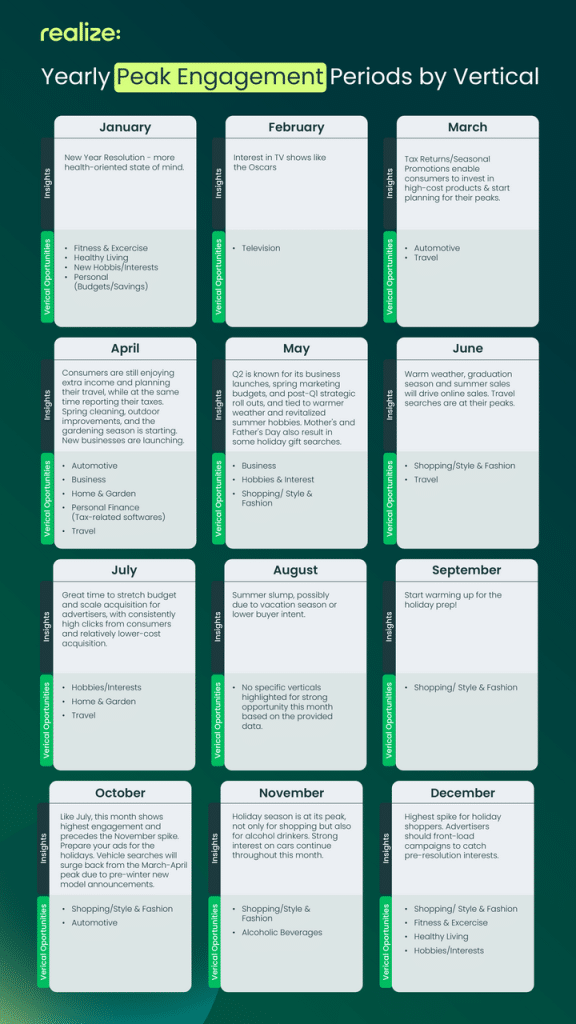Understanding when consumers are most engaged is a vital piece of knowledge for advertisers. It enables them to time campaigns with consumer intent, which increases clicks, maximizes ROI, and improves conversions.
To help, we collected Realize data from 2022 to the present, to determine the peak engagement periods for several key verticals. The insights in this report reveal when user clicks on vertical-specific ads peak, helping you decide when to prepare, scale, or adjust your campaigns for maximum impact.

Fitness & Exercise/Healthy Living
Peak months: January, December
Unsurprisingly, fitness and healthy living campaigns perform their best at the start of the year, when consumers are setting their New Year’s resolutions and trying to adopt a more health-oriented mindset. Ad clicks in this vertical surge as people look to purchase exercise equipment, join gyms and fitness programs, and commit to new eating habits.
The spike in clicks doesn’t suddenly appear on January 1st, though: Engagement begins to rise in December, as consumers think ahead and begin to plan for the new year. But, it’s a narrow window: By March, interest in this vertical falls dramatically as people lose their motivation to stick with their resolutions.
Our recommendation: Your best bet is to front-load your campaigns in December to capture those early planners. Then, double down in January when consumers are at their peak engagement. In other words, prepare to scale your budget before cutting back in March.
Television
Peak months: February, March, and the fall months
Television engagement trends align with seasonal programming and significant cultural events. For example, fall is a key period because it’s when many TV programs premiere their new seasons and streaming platforms offer new releases.
That said, some of the biggest audience spikes happen earlier in the year, in February and March, when nominations for the Oscars, Golden Globes, and Emmys drive audiences to search for shows, actors, and other related content.
Our recommendation: Align your ad campaigns with these peak seasonal periods. Fall will offer more consistent opportunities, but prepare for concentrated bursts of ad spend early in the year.
Automotive
Peak months: March, April, October, November
The automotive vertical sees very consistent surges during spring and fall. In March and April, consumers, armed with cash from their tax refunds, may be feeling confident about making big-ticket purchases. Seasonal promotions during this period don’t hurt, either.
Vehicle searches spike again in October and November. This is due to several factors, including new model announcements from manufacturers, pre-winter car preparation for many drivers, and dealership incentives designed to clear inventory.
It’s worth noting that ad competition peaks in April and May, which reflects the heightened interest during the spring season.
Our recommendation: When creating your annual strategy, plan automotive ad campaigns around the spring and fall peaks. Consider the intent driving consumer demand and optimize your ad creative and budgets accordingly.
Business
Peak months: April, May
Business-related ad clicks spike in April and May, which aligns with Q2 business launches and spring marketing budgets, as well as the rollout of business strategies set during Q1. Clicks and ad competition remain high throughout the fall, demonstrating sustained demand for B2B solutions, tools, and services for most of the year.
Our recommendation: Advertisers in the business vertical should consider spring as the prime time to launch campaigns and plan to maintain momentum into Q3 and Q4 to capitalize on ongoing demand.
Shopping/Style & Fashion
Peak months: November, December, May, June, September, October
Not many verticals are as cyclical as shopping and fashion. The largest spikes occur in November and December, driven by shopping holidays like Black Friday and Cyber Monday, as well as holiday gift-buying, which fuel enormous volumes of clicks.
There are smaller peaks in May and June, due to Mother’s Day, Father’s Day, graduations, and the start of summer sales. And, don’t forget September and October, as they are a key period for advertisers looking to ramp up holiday preparations.
Our recommendation: Anchor your strategy around the holiday season, making sure that you test your campaigns early and warm up audiences who have started browsing. Don’t ignore smaller yet significant mid-year opportunities.
Hobbies/Interests
Peak months: January, May, June, July
January brings a consistent spike in engagement around hobbies and personal interests. This may be due to a mix of seasonal and motivational drivers — for example, people often set resolutions to start new personal projects, like crafts or music.
Another spike comes when the warmer weather hits, with increased activity in May, June, and July. During this time, consumers are taking up summer hobbies and outdoor activities.
Our recommendation: Take advantage of the January “restart” and the summer surge, and tailor your messaging to resolutions in Q1 and lifestyle pursuits in Q2 and Q3.
Travel
Peak months: March, April, June, July
Our data show that travel ad clicks increase steadily from March through June and July. This aligns with summer vacation planning. Similarly, like the trend seen in the automotive industry, many consumers are looking for ways to spend their tax refunds.
Our recommendation: Begin ramping up ad spending in early spring to capture consumers’ attention during their peak travel planning season. Ensure you sustain your investment through the summer to reach consumers right up to the point of booking.
Home & Garden
Peak months: April, May, June, July
Unsurprisingly, the spring and summer seasons are synonymous with home and garden projects. From April to May, consumers spend time on spring cleaning, home improvements, and gardening.
Our recommendation: Align your campaigns with these seasonal behaviors. Spring is the kickoff, but summer provides additional opportunities.
Alcoholic Beverages
Peak months: November (extends over the holiday season)
Ad clicks for alcoholic beverages spike in November, likely due to holiday drinking during Thanksgiving, Christmas, and New Year’s celebrations. While the shopping window extends into December, you want to get ahead of consumer demand in November to maximize the increase in sales.
Our recommendation: Consider November your core advertising season, but make sure campaigns continue into December to maximize the entire holiday season.
Personal Finance
Peak months: January, April
The personal finance vertical is predictable, with consumers particularly interested in budgeting, savings, and debt repayment at the start of the year, and tax software and preparation around the April tax-filing deadline.
Our recommendation: Focus heavily on these two seasonal peaks. During January, position your messaging around budget and savings tools. In April, lean into tax assistance and compliance products, like tax software.
Key Takeaways
Now that you have insight into peak engagement periods, you can maximize ROI by aligning your campaigns with predictable seasonal peaks across several verticals. For example, fitness and personal finance surge in January, while the spring tax season also fuels finance and business engagement.
Shopping, fashion, and alcoholic beverages see their strongest spikes during the holiday season, while consumers are interested in travel, automotive, and home and garden during the spring and summer seasons. By aligning your ad spend and creative strategy with these specific windows, you can capture consumer intent at its highest point.



